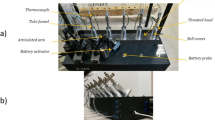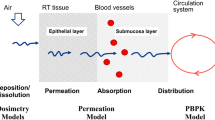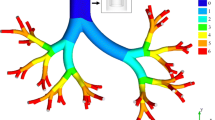Abstract
Respiratory tract dosimetry predictions for inhalation of tobacco product smoke and aerosols are sensitive to the values of the physicochemical properties of constituents that make up the puff. Physicochemical property values may change significantly with temperature, particularly in the oral cavity and upper airways of the lung, where the puff undergoes adjustments from high temperatures in the tobacco product to reach body temperature. The assumption of fixed property values may introduce uncertainties in the predicted doses in these and other airways of the lung. To obtain a bound for the uncertainties and improve dose predictions, we studied temperature evolution of the inhaled puff in the human respiratory tract during different puff inhalation events. Energy equations were developed for the transport of the puff in the respiratory tract and were solved to find air and droplet temperatures throughout the respiratory tract during two puffing scenarios: 1. direct inhalation of the puff into the lung with no pause in the oral cavity, and 2. puff withdrawal, mouth hold, and puff delivery to the lung via inhalation of dilution air. These puffing scenarios correspond to the majority of smoking scenarios. Model predictions showed that temperature effects were most significant during puff withdrawal. Otherwise, the puff reached thermal equilibrium with the body. Findings from this study will improve predictions of deposition and uptake of puff constituents, and therefore inform inhalation risk assessment from use of electronic nicotine delivery systems (ENDS) and combusted cigarettes.








Similar content being viewed by others
References
Airey, J. The numerical calculation of the roots of the Bessel function Jn(x) and its first derivative Jn’(x). Lond. Edinb. Dubl. Phil. Mag. 34(201):189–195, 1917.
Asgari, M., F. Lucci, J. Bialek, B. Dunan, G. Andreatta, R. Smajda, S. Lani, N. Blondiaux, S. Majeed, S. Steiner, J.-P. Schaller, S. Frentzel, J. Hoeng, and A. K. Kuczaj. Development of a realistic human respiratory tract cast representing physiological thermal conditions. Aerosol Sci. Technol. 53:860–870, 2019.
Asgharian, B., O. T. Price, A. A. Rostami, and Y. B. Pithawalla. Deposition of inhaled electronic vapor products in the respiratory tract. J. Aerosol Sci. 126:7–20, 2018.
Broday, D. M., and P. G. Georgopoulos. Growth and deposition of hygroscopic particulate matter in the human lungs. Aerosol Sci. Technol. 34:144–159, 2001.
Burch, G. E. Rate of water and heat loss from the respiratory tract of normal subjects in a subtropical climate. Archs Int. Med. 76:15–327, 1945.
Chen, W., P. Wang, K. Ito, J. Fowles, D. Shusterman, P. Jaques, and K. Kumagai. Measurement of heating coil temperature for e-cigarettes with a “top-coil” clearomizer. PLoS ONE. 13(4):e0195925, 2018.
Cheng, K. H., Y. S. Cheng, H. C. Yeh, and D. L. Swift. Measurements of airway dimensions and calculation of mass transfer characteristics of the human oral passage. J. Biomed. Eng. 119:475–482, 1997.
Cheng, Y. S., Y. Zhou, and B. T. Chen. Particle deposition in a cast of human oral airways. Aerosol Sci. Technol. 31:286–300, 1999.
Choi, J., M. H. Tawhai, E. A. Hoffman, and C.-L. Lin. On intra- and intersubject variabilities of airflow in the human lungs. Phys. Fluids (1994-present). 21:101901, 2009.
Cole, P. Some aspects of temperature, moisture and heat relationships in the upper respiratory tract. J. Laryngol. Otol. 67:449–456, 1953.
Cole, P. Further observations on conditioning of respiratory air. J. Laryngol. Otol. 67:669–681, 1953.
Cramer, I. I. Heat and moisture exchange of respiratory mucous membrane. Ann. Otol. Rhinol. Lar. 66:327–343, 1957.
Daviskas, E., I. Gonda, and S. D. Anderson. Mathematical modeling of heat and water transport in human respiratory tract. J. Appl. Physiol. 69(1):362–372, 1990.
Dery, R., J. Pelletier, A. Jacques, M. Clavet, and J. J. Houde. Humidity in anaesthesiology III. Heat and moisture patterns in the respiratory tract during anaesthesia with the Semi-closed System. Canad. Anaesth. Soc. J. 14:287–298, 1967.
Engineering ToolBox. Dry air properties, 2005. https://www.engineeringtoolbox.com/dry-air-properties-d_973.html.
Ermala, P., and L. R. Holsti. On the burning temperatures of tobacco. Cancer Res. 16(6):490–495, 1956.
Ferron, G. A., B. Haider, and W. G. Kreyling. Method for the approximation of the relative humidity in the upper human airways. Bull. Math. Biol. 47:565–589, 1985.
Ferron, G. A., B. Haider, and W. G. Kreyling. Inhalation of salt aerosol particles – I. Estimation of the temperature and relative humidity of the air in the human upper airways. J. Aerosol Sci. 19:343–363, 1988.
Ferrus, L., H. Guenard, G. Vardon, and P. Varene. Respiratory water loss. Respir. Physiol. 39:367–438, 1980.
Hanna, L. M., and P. W. Scherer. A theoretical model of localized heat and water vapor transport in the human respiratory tract. J. Biomech. Eng. 108:19–27, 1986.
Haut, B., A. Nonclercq, A. Buess, J. Rabineau, C. Rigaut, and B. Sobac. Comprehensive analysis of heat and water exchanges in the human lungs. Front. Physiol. 12:649497, 2021. https://doi.org/10.3389/fphys.2021.649497.
Ingebrethsen, B. J., S. K. Cole, and S. L. Alderman. Electronic cigarette aerosol particle size distribution measurements. Inhal. Toxicol. 24(14):976–984, 2012. https://doi.org/10.3109/08958378.2012.744781.
Ingelstedt, S. Studies on the conditioning of air in the respiratory tract. Acta Otolaryngol. Suppl. 131:1–80, 1956.
Ingenito, E. P., J. Solway, E. R. Mcfadden, B. M. Pichurko, E. G. Cravalho, and J. M. Drazen. Finite difference analysis of respiratory heat transfer. J. Appl. Physiol. 61:2252–2259, 1986.
McAdam, K., A. Warrington, A. Hughes, D. Adams, J. Margham, C. Vas, P. Davis, S. Costigan, and C. Proctor. Use of social media to establish vapers puffing behaviour: findings and implications for laboratory evaluation of e-cigarette emissions. Regul. Toxicol. Pharmacol. 107:104423, 2019.
McFadden, E. R., B. M. Pichurko, F. Bowman, E. Ingenito, S. Burns, N. Dowling, and A. J. Solway. Thermal mapping of the airways in humans. J. Appl. Physiol. 58:564–570, 1985.
McGrath, C., N. Warren, P. Biggs, and J. McAughey. Real-time measurement of inhaled and exhaled cigarette smoke: implications for dose. J. Phys. 2009. https://doi.org/10.1088/1742-6596/151/1/01.
Perwitzschky, R. Die Temperatur und Feuchtigkeitsverhaltnisse der Atemluft in den Luftwegen. Arch. Ohrenheil. 117:l-36, 1928
Proctor, D. F., I. Andersen, and G. R. Lundqvist. Clearance of inhaled particles from the nose. Arch. Int. Med. 131:132–139, 1973.
Raabe, O. G., H. C. Yeh, G. M. Schum, and R. F. Phalen. Tracheobronchial Geometry: Human, Dog, Rat, Hamster; Report LF-53. Albuquerque, New Mexico: Lovelace Foundation, 1976.
Rowell, T. R., and R. Tarran. Will chronic e-cigarette use cause lung disease? Am J. Physiol. Lung Cell Mol Physiol. 309:1398–1409, 2015.
Soulet, S., M. Duquesne, J. Toutain, C. Pairaud, and M. Mercury. Impact of vaping regimens on electronic cigarette efficiency. Int. J. Environ. Res. Public Health. 16:4753, 2019. https://doi.org/10.3390/ijerph16234753.
Tsu, M. E., A. L. Babb, D. D. Ralph, and M. P. Hlastala. Dynamics of heat, water, and soluble gas exchange in the human airways: I. A model study. Ann. Biomed. Eng. 16:547–571, 1988.
Verzar, F., J. Keith, and V. Parchet. Temperature and air humidity in the respiratory tract. Pflugers Arch Gesamte Physiol Menschen Tiere. 257(5):400–416, 1953.
Webb, P. Air temperatures in respiratory tracts of resting subjects in cold. J. Appl. Physiol. 4:378–382, 1951.
Wu, D., M. H. Tawhai, E. A. Hoffman, and C.-L. Lin. A numerical study of heat and water vapor transfer in MDCT-based human airway models. Ann. Biomed. Eng. 42(10):2117–2131, 2014.
Yeh, H. C., G. M. Schum, and M. T. Dugan. Anatomical models of the tracheobronchial and pulmonary regions of the rat. Anat. Rec. 195:483–492, 1979.
Acknowledgments
The findings and conclusions in this report are those of the authors and do not necessarily represent the official position of the Food and Drug Administration. Research reported in this publication was supported by Food and Drug Administration (FDA) Center for Tobacco Products (CTP). We would like to thank Scott Wasdo, Cissy Li, Anwar Husain, and Kamau Peters for their review and helpful comments during the preparation of the manuscript.
Funding
Funding was provided by Center for Tobacco Products (Grant No. HHSF223201610113C).
Author information
Authors and Affiliations
Corresponding author
Ethics declarations
Conflict of interest
The authors declare that they have no known conflict of interest.
Additional information
Associate Editor Stefan M. Duma oversaw the review of this article.
Publisher's Note
Springer Nature remains neutral with regard to jurisdictional claims in published maps and institutional affiliations.
Supplementary Information
Below is the link to the electronic supplementary material.
Rights and permissions
Springer Nature or its licensor holds exclusive rights to this article under a publishing agreement with the author(s) or other rightsholder(s); author self-archiving of the accepted manuscript version of this article is solely governed by the terms of such publishing agreement and applicable law.
About this article
Cite this article
Asgharian, B., Price, O., Creel, A. et al. Simulation Modeling of Air and Droplet Temperatures in the Human Respiratory Tract for Inhaled Tobacco Products. Ann Biomed Eng 51, 741–750 (2023). https://doi.org/10.1007/s10439-022-03082-0
Received:
Accepted:
Published:
Issue Date:
DOI: https://doi.org/10.1007/s10439-022-03082-0




